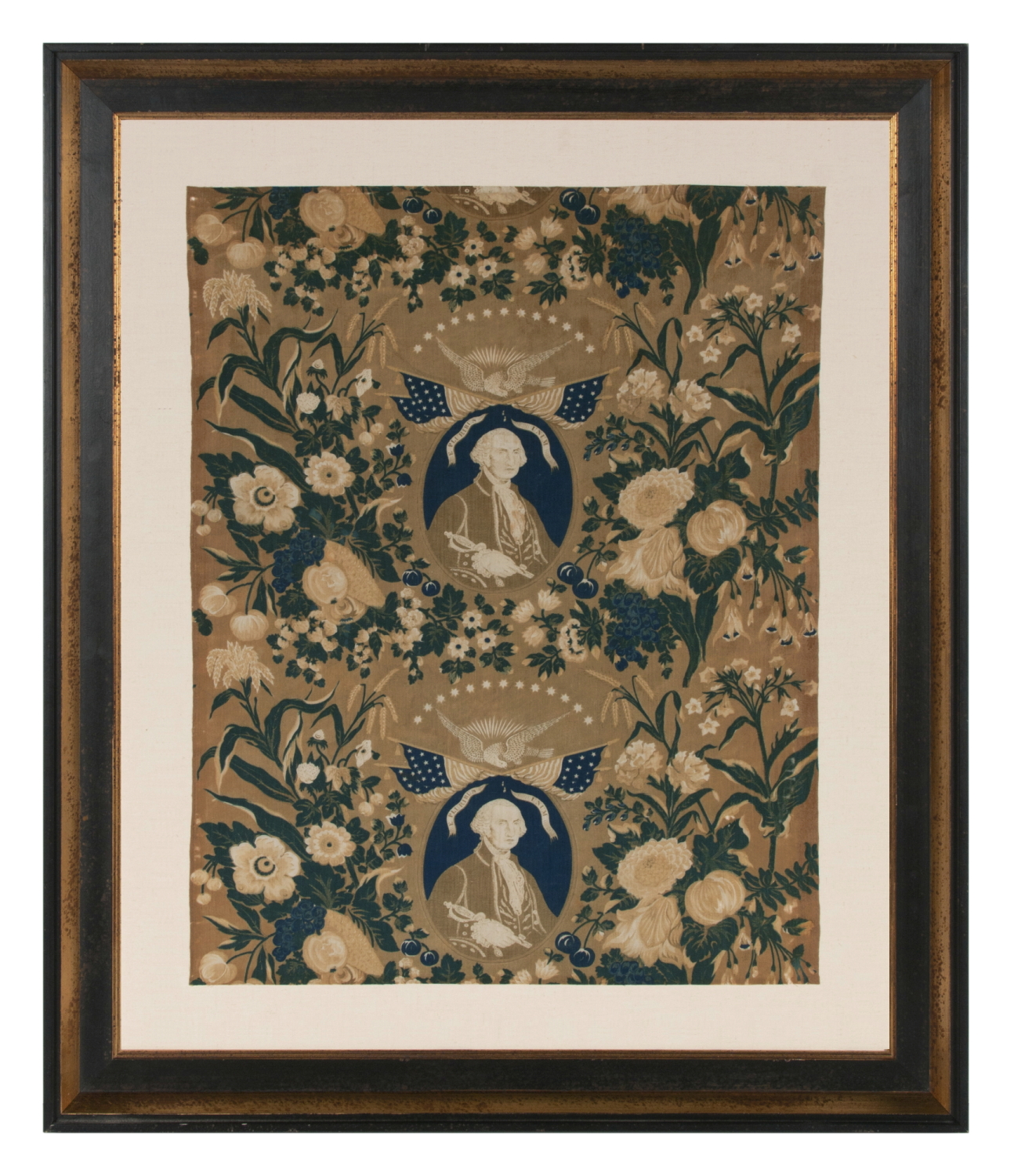


| ROLLER-PRINTED YARD GOODS TEXTILE, MADE TO MEMORIALIZE GEORGE WASHINGTON SOMETIME BETWEEN LAFAYETTE’S FINAL VISIT & GRAND TOUR OF AMERICA, FROM 1824-25, AND THE 1832 CELEBRATION OF GEORGE WASHINGTON'S 100th BIRTHDAY |
|
| Web ID: | pat-596 |
| Available: | In Stock |
| Frame Size (H x L): | 45.5" x 38.25" |
| Flag Size (H x L): | 34.25" x 27" |
| Description: | |
| Roller-printed on cotton and thought to be of American origin, this yard goods textile was probably produced sometime between Lafayette’s final visit to and grand tour of the U.S., in 1824-25, and the 100th birthday of George Washington in 1832, which was widely celebrated. Due to the 50-year anniversary of our nation’s independence in 1826, which occurred in the midst of these two significant events, this was an extremely patriotic period. The imagery features an oval medallion with a portrait of George Washington, in sepia ink, on a striking blue background. Above this is a spread-winged eagle, flanked by 13 star flags in the 4-5-4 configuration, over which are 13 seven-pointed stars in a wide arc. Surrounding it all and stretching to the borders is a floral design of leaves, flowers, fruit, and wheat stalks. An example of this textile, among the collection of the New York Historical Society, is documented in “Threads of History: Americana Recorded on Cloth, 1775 to the Present”, by Herbert Ridgeway Collins, Smithsonian Press, 1979 (item 77, pg. 81). This is the best text on American political textiles. Collins formerly served as Curator of Political History at the Smithsonian Institution. Collins dates the textile to 1830 specifically, but does not provide explanation. Knowing something about how the book was compiled, I’d suggest that this date was probably attributed by the New York Historical Society and a conclusion of educated guesswork, as opposed to decisive knowledge of production. I’d suggest that a specific occasion drove the need for such a fabrics, perhaps one of the two aforementioned events. Lafayette and Washington were great friends. It may be that the fabric was produced to honor him and gain some favor with the Frenchman who selflessly aided the rebellion. Mounting: The flag was mounted and framed by us in-house. We take great care in the mounting and preservation of flags and related textiles and have preserved thousands of examples. For 25 years we have maintained our own textile conservation department, led by a master’s degree level graduate from one of the nation’s top programs. The background is 100% hemp fabric, ivory in color. The mount was placed in a black-painted, hand-gilded and distressed Italian molding. The glazing is U.V. protective acrylic (Plexiglas). Feel free to contact us for more details. Provenance: I purchased this fabric at the Winter Antique Show in New York City from the late Joe Kindig, Jr.. When I acquired it, the fabric was part of three panels joined to create a quilt top. Because lengths of this fabric of this scale are practically unknown outside institutional collections, and because the summer quilt was undesirable as an entire object, I decided to thoughtfully disassemble it, carefully conservation mount and frame larger sections that anyone was likely to ever encounter, and sell the lengths individually. Condition: There is modest fading. There are stitch tracks from the assembly and quilting, from the summer quilt of which this was formerly a part (see provenance, above). |
|
| Video: | |
| Collector Level: | Advanced Collectors and the Person with Everything |
| Flag Type: | |
| Star Count: | |
| Earliest Date of Origin: | 1824 |
| Latest Date of Origin: | 1832 |
| State/Affiliation: | |
| War Association: | 1777-1860 Pre-Civil War |
| Price: | Please call (717) 676-0545 or (717) 502-1281 |
| E-mail: | info@jeffbridgman.com |
 |
|